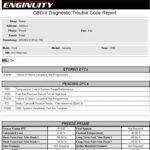Choosing the right scan tool for your car can be overwhelming with the vast array of options available. Understanding the different types of scan tools and their functionalities is crucial for making an informed decision. This guide will break down the various types of automotive scan tools, from basic code readers to professional-grade diagnostic systems, to help you find the perfect fit for your needs.
1. Basic OBD2 Code Readers
Engine code readers are entry-level OBD2 scanners designed to diagnose engine-related trouble codes. These tools can identify the reason for a check engine light, providing the error code and its description. Basic code readers can also clear the codes and reset the check engine light. While they lack advanced features, they are a cost-effective solution for simple diagnostics. Some models offer enhanced Mode 6 data, allowing for more in-depth analysis of emissions and sensor performance.
2. Bluetooth/WiFi OBD2 Scanners for Smartphones
Wireless OBD2 scanners, utilizing Bluetooth or WiFi, connect to your smartphone or tablet, transforming your device into a powerful diagnostic tool. These scanners provide real-time data, allowing you to monitor various engine parameters and diagnose trouble codes using compatible apps. Functionality varies depending on the app and scanner, ranging from basic engine diagnostics to multi-system analysis. They are convenient for on-the-go diagnostics and data logging.
3. OBD2 Gauges and Monitors
OBD2 gauges and monitors provide real-time displays of critical vehicle parameters like engine temperature, coolant temperature, oil pressure, and battery voltage. These tools offer a constant visual representation of your car’s performance, allowing you to quickly identify potential issues. Some advanced models can track fuel consumption, speed, and trip data.
4. Multi-System Scan Tools
Multi-system scan tools expand diagnostic capabilities beyond the engine, accessing systems like ABS, SRS (airbags), transmission, and body control modules. These tools offer a more comprehensive overview of vehicle health, enabling diagnosis of a wider range of issues. Functionality can range from basic code reading and clearing to advanced bi-directional control of vehicle systems and service resets.
5. Single-Make Scan Tools
Designed for specific car brands, single-make scan tools offer in-depth diagnostics and specialized functionalities tailored to a particular manufacturer’s vehicles. These tools provide access to proprietary systems and functions not available on generic OBD2 scanners, enabling comprehensive diagnostics and advanced programming capabilities.
6. Professional OBD Scan Tools
Professional scan tools offer the most comprehensive diagnostic and programming capabilities, covering a wide range of vehicle makes and models. These tools provide access to all vehicle systems, advanced bi-directional controls, coding functionalities, and specialized tests. Often featuring robust hardware and software, they are essential for professional mechanics and workshops.
7. Service Reset Scan Tools
Service reset tools are specialized scanners designed to perform maintenance tasks such as oil resets, EPB (electronic parking brake) service, TPMS (tire pressure monitoring system) resets, and other service-related functions. These tools simplify routine maintenance procedures and can help avoid costly trips to the mechanic.
8. OBD1 to OBD2 Adapters
For vehicles manufactured before the OBD2 standard was implemented, OBD1 to OBD2 adapters allow you to use an OBD2 scanner for diagnostics. These adapters bridge the gap between older vehicle diagnostic systems and modern scan tools. However, functionality may be limited depending on the vehicle and adapter.
Choosing the right scan tool depends on your individual needs and budget. Whether you’re a DIY enthusiast or a professional mechanic, understanding the different types of scan tools available empowers you to make the best choice for accurate diagnostics and effective vehicle maintenance.

